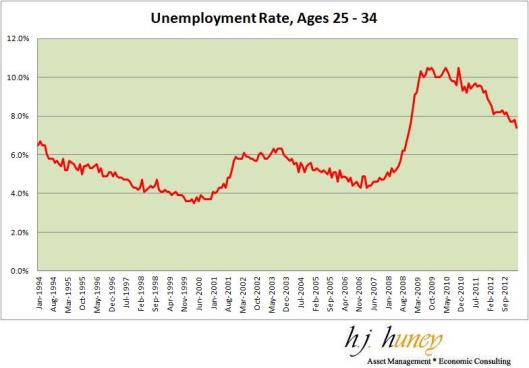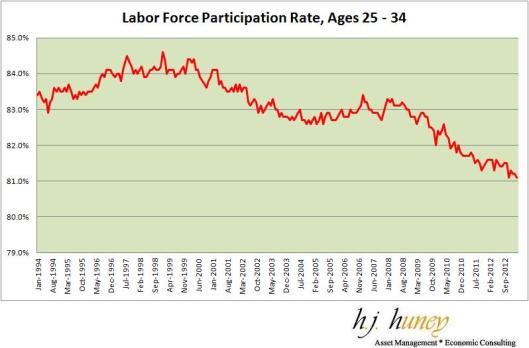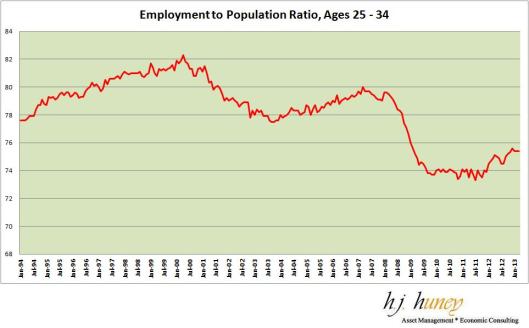Tags
aca, bls, demographics, economics, economy, employment, federal reserve, jake huneycutt, labor, labor market, labor statistics, minimum wage, obamacare, politics, ppaca, regulations, unemployment
There’s a lot of debate about the recent unemployment numbers. While the headline unemployment rate continues to creep downward, this is at least partly due to the fact that the labor force participation (“LFP”) rate is declining. This has led many to question whether the official unemployment figure is painting a picture much rosier than reality.
In this discussion over the “true unemployment rate,” one side argues that the declining LFP rate is a sign that the true unemployment rate is declining much slower than the official number. On the other end of the spectrum, some have argued that the falling LFP rate is merely the result of a demographic shift with an increasing number of “Baby Boomers” entering into retirement; for this reason, they see the official unemployment rate as a reasonable proxy. Naturally, there are many people who are in between the two extremes.
My personal take is that the declining LFP rate may be partly explained by demographics, but that overall, the job market is still unhealthy. If demographics were the primary cause of the low LFP rate, then we should see real wage gains as the supply of labor declined. This is basic supply and demand; a declining labor force should lead to higher prices.
Instead, we have seen subpar wage growth, which seems to suggest that demographics aren’t the main culprit. A quick Google search turns up a Wall Street Journal article showing stagnant wage growth over the past 12 months. Likewise, there’s an interesting and fairly detailed blog on this subject at Zero Hedge: The Mysterious Case of America’s Negative Real Wage Growth.
I see stagnant wage growth as a chink in the demographic argument, but I decided to take a closer look. It’s simple enough to eliminate the impact of retiring Baby Boomers on employment figures, by focusing on specific age groups. For this exercise, I decided to examine the 25 – 34 year old age bracket to see how unemployment and labor force participation has changed for this group since 1994.
Employment for the 25 – 34 Year Old Age Group
First of all, let’s look at the unemployment rate for this age cohort
We can see in this chart that the unemployment rate for this group peaked around August 2009 at 10.5%. Since then, it has slowly declined to 7.4%. Now the question becomes how much of this is due to discouraged workers not being counted. For that, we should look at the labor force participation rate.
In August 2009, the LFP rate for this age bracket was 82.8%. By March 2013, it had fallen to 81.1%. From this, we can see that at least a good chunk of the drop in unemployment, even in the 25 – 34 year old age bracket, is coming from discouraged workers not being counted in the unemployment statistics.
If we still counted 82.8% of this age bracket as ‘participating in the labor force,’ the unemployment rate for this age group would be 9.3% rather than 7.4%. This is an improvement from the 10.5% unemployment rate we saw in August ’09, but not nearly as dramatic as the 7.4% unemployment rate seems to imply.
Here’s one final chart that shows a similar stat, and that’s the Employment to Population ratio, for the 25 – 34 age cohort. This is the most enlightening chart of all.
Here we can see an even more interesting long-term dynamic, with 25 – 34 year old employment peaking in April 2000 at 82.3%. It declined during the early 00’s recession, before peaking again at 80.0% in March 2007. Surprisingly, this figure doesn’t bottom until July 2011 when it hits 73.3%. It has since risen back up to 75.4%.
From the employment-to-population ratio, we can see some disturbing trends in US employment. It appears we are on a downward trajectory overall, and even at the height of the recovery, we’re still at a lower level than the trough of the last recession (77.5% in Sep ’03).
While we can still debate the true measure of employment, I think this throws the demographic argument mostly out of the water. Unless one argues that 25 – 34 year olds are retiring in significant numbers, the extraordinarily low employment-to-population ratio here must be explained by something else. The fact of the matter is that we aren’t creating enough jobs, and that may be the result of structural issues in the US economy.
We’ve seen an increasing number of labor market restrictions implemented by several state governments over the past few decades. This is on top of an increase in the Federal minimum wage, and soon-to-come implementation of the Affordable Care Act. One has to wonder if these policy measures bear a bit of responsibility for the declining long-term employment numbers.


